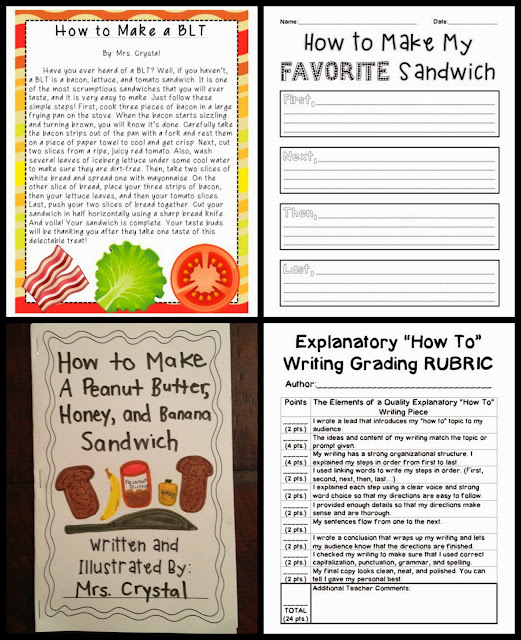I had so much fun when I first introduced the unit.
I brought into school a loaf of bread, peanut
butter, jelly, a butter knife, and napkins. I began the lesson by asking the
class, "What are directions?" We built a definition together based on
our discussion and wrote it on the board. We came up with, "Directions are
a list of steps that you follow to learn something new or to complete a
task." Next, we talked about "How do we use directions in real life?"
We generated a list on the board: A recipe gives directions on how to
cook something, a board game gives directions on how to play it, Legos and
models give directions on how to build them, teachers give directions in school
on how to complete an assignment, parents give directions on how to do a chore,
etc.
Then, it was time for the fun part! I told
students that today, they would be giving me oral directions on how to make a
peanut butter and jelly sandwich. I explained to the class that I was a robot
and had never made a sandwich before—I
could only do what they directed me to do. I got out the bread, peanut butter,
jelly, knife, and napkins and had students give me directions one step at a
time on how to make the sandwich. I made sure that my students were really
SPECIFIC. This is where it got a little entertaining because I only did what
students directed me to do. For example, when a student told me to get out the
bread, I started to turn the bag over and said that I was going to dump out the
whole bag. The student then exclaimed, "No, don't dump out the whole
bag! Just get out two slices." I explained that now I knew exactly what to
get out and proceeded with pulling only two slices of bread out of the
bag. When a student told me to put on the peanut butter without having
told me to first open the jar, I tapped the knife against the top of the lid
and looked confused. The student quickly clarified that I needed to open the
jar by twisting off the top. When a student told me to put the peanut butter on
the bread, I put a huge glob right in the center of the slice. Then, I smiled and asked what I needed to do next. The student told me that I had to
actually spread the peanut butter; I couldn't just leave it in a big blob.
Students of course laughed and found this quite hilarious, but in the end, they
were learning how to use specific step-by-step language when giving
directions. Of course while students were off into brainstorming and pre-writing, I had to whip up some extra sandwiches to snack on. You can't make a delicious sandwich right in front of a class of 27 seven-year-olds and not let them have a taste!
As we went through the whole pre-writing
and then rough draft process, I could see that my little stunt had really paid
off. My students were super specific in their language!!
To look at this unit up close, just click here "How to Make My Favorite Sandwich" Common Core Aligned Explanatory Writing Unit
or on the picture below!
This unit comes with a detailed 3 week lesson plan, anchor papers to help
students see what quality explanatory pieces look like or for the teacher to
use as his/her own to model the writing process day-by-day, a "What I
Will Need" brainstorming paper, a spelling menu to help students with
ideas as well as spelling, several graphic organizers to choose from based on
the needs of your students, a rough draft template, a peer revising
form, a final copy book template, a "how to" explanatory
writing student self-evaluation, a "how to" explanatory writing
rubric, and examples of the pre-writing template, graphic organizers, etc. in
relationship to the anchor papers to show students as examples or to be used by
the teacher as his/her own to model.
I can't wait to see the finished copies wrap up this week!




No comments:
Post a Comment